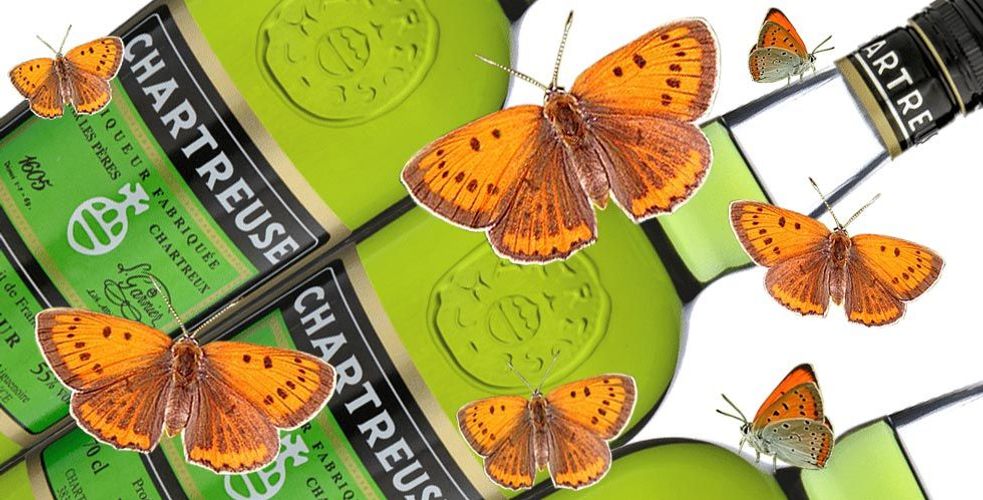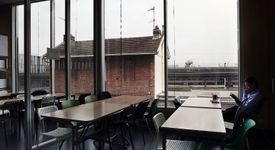La Chartreuse Verte, the anti-Miraval? The Prior General, Brad Pitt and the Large Copper Butterfly

Why is there a Chartreuse shortage? Ask the Monks Who Make it. The New York Times.
No green Chartreuse for sale on Amazon, at Lidl or on marketplaces. It's the only naturally green liqueur in the world and its producers, the Carthusian monks, have decided to limit production and therefore sales, to the extent that the prestigious New York Times has written about it and them. And the Marsh Copper, a butterfly that had become rare in Isère, had to be protected.
In Correns, in the Var, a different strategy is at work, implemented by Brad Pitt and the Perrin family, on a 900-hectare winegrowing estate that was the birthplace of Miraval, the legendary studio. Emmanuel Delafon, CEO of Chartreuse Diffusion, and Brad Pitt share a love of France and its remote corners, but they don't have the same strategy or the same time horizon for their spirits company. In the Var region of France, in partnership with the Perrin family, the American actor is working hard to produce and sell a rosé that is very much in the 'Instagram' spotlight.

Is it possible to offer customers an unforgettable experience while respecting the future, the environment, our partners, protected animal species such as the Marsh Copper, the European Barbastelle, a butterfly and a bat? Yes, sometimes by limiting the number of customers and visitors, by choosing to set up a new factory with prior environmental impact studies, and by favouring sales in boutiques. Rather than an e-shop.
In September, En-Contact invites you to discover a new section: customer and employee experience ... in times of frugality :)
The series will therefore open with the story of merchants who are not entirely focused on unbridled growth, but rather on limiting sales, solitude and calm: one of the oldest liqueurs in the world, made by the Carthusian monks near Voiron, has decided this year to limit the production and marketing of its product. On 29 January 2023, a letter went viral on social networks: "The Carthusian monks have decided not to increase production volumes (...) in order to concentrate on their main objective: to protect their monastic life and devote their time to solitude and prayer.
Infinite growth is no longer an option
In 2016, when it was due to build a new factory, the company commissioned an impact study* on the species that its warehouses and production facilities might disturb. Unluckily, the Swamp Copper, a butterfly belonging to a protected species, was spotted in the region. As well as a species of bat. We're going to have to think about compensating or ensuring that the butterfly can go and feed in the field opposite. Cooperation with the farmer who owns the plot will make this possible.
Meanwhile, in Correns, in the Var, at Miraval, until recently known for its famous recording studio where Pink Floyd, the Cure, Chris Rea and Maxime le Forestier have played, the couple Angelina and Brad Pitt have taken up residence. The latter decided to produce rosé wine, with the help of Marc Perrin, and bring the studio back to life. All of this was done with a profusion of resources, photos and American-style communication: journalists invited to report on the opening were hand-picked, it was impossible to take photos other than those supplied by the studio, and the language was pre-supplied. Damien Quintard, a sound engineer billed as a genius but somewhat unknown in the profession, was given the task of breathing new life into the studio and filling it with wealthy bookers, one assumes.
In contrast, Emmanuel Delafon, who has been Chairman of Chartreuse Diffusion for eleven years, explained on Radio France in 2022 that, at the request of the Prior General, a new spirit should reign in the company: "infinite growth is no longer possible".
Living heritage companies (the CFGC is one of them) are a good illustration of this question that is stirring up the tourism and food sectors: is industrialising the experience, mass-producing the memorable and the unforgettable, desirable and possible?
The intense life, a modern obsession
If all these proposals for experiences are flourishing and we like to indulge in them, sometimes carelessly, it's because modernity now consists of living intensely, multiplying experiences to avoid routine. This is the message, summed up very well, of Tristan Garcia's instructive essay: La Vie intense une obsession moderne. (Editions Autrement)
"By 'intensive man', we mean a subject subjected to the demand to be intense (...) in order to respond to the social injunction to love, work and enjoy oneself ever more intensely". But intensity experienced as an obligation condemns us to becoming bored very quickly, adds the philosopher: “Unlike religions, which promise truth, eternity or grace, intensity does not promise anything else but more of the same. For two centuries we've lived on promises of intensity: Rimbaud, the Surrealists, the Futurists. But like all promises, the ideal of intensity wears thin. Sexual freedom and sport have reached their limits. Even transgression has run out of steam. And there will probably be a return to the past, with a desire for older, religiously-based ethical values. And I don't want that.” (Interview with the author, in Grazia).

To find out more
In 2012, Brother Jean-Jacques was one of only two brothers to know the exact recipe for making the precious liqueur, which was widely publicized in a scene from a Quentin Tarantino film. As a precaution, the two brothers would not be allowed to travel together in the same car.
Why is La Chartreuse a 'victim' of its success in the United States? Read about it here. With a report by Cécile Mathy.
Read more in the next issue of Cahiers de l'Expérience Client:
Water reserves when bottling: Coca Cola, La Compagnie Française de Grande Chartreuse.
The history of Chartreuse liqueurs dates back to 1605, when the Maréchal d'Estrées handed over a mysterious manuscript to the Carthusian monks. After many years of research, this list of 130 plants, spices and flowers was used to make the Plant Elixir. Several liqueurs were subsequently developed, including Chartreuse verte and Chartreuse jaune. CFGC is 100% owned by the Carthusian monks, via SA Rural Medicis.
In 2014, following a study carried out by the Compagnie Française de Grande Chartreuse, the CFGC was forced to move some of its facilities from Voiron to the commune of Entre-Deux-Guiers. It is impossible to continue distillation and storage in an urban environment.
Manuel Jacquinet.






